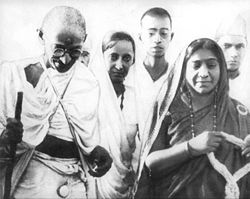Mithuben Petit


Mithuben Hormusji Petit (11 April 1892 – 16 July 1973) was one of the pioneer Indian independence female activists[1][2] who participated in Mahatma Gandhi's Dandi March.[3][4]
Biography[edit]
Born on 11 April 1892 into an affluent Parsi Zoroastrian family in Bombay (now Mumbai), Mithuben Petit's father was Sir Dinshaw Maneckji Petit, a well-known industrialist, philanthropist, and Baronet.[5][6] Her activism was met with challenges by the Petit family, who urged her to renounce her activism or risk disinheritance, to which she refused and responded: "It is your business to sit with the government and mine to remain with the nation."[7].
Indian independence movement[edit]
The young Petit Baroness was influenced by her aunt, Jaiji Jehangir Petit, who was a follower of Mahatma Gandhi and was the Secretary of the Rashtriya Stree Sabha, a women's movement founded on Gandhian ideals.[8] Petit, along with Kasturba Gandhi and Sarojini Naidu, played a major part in the Salt March,[9] with Kasturba Gandhi beginning the march at Sabarmati, Sarojini Naidu lifting the salt for the first time at Dandi on 6 April 1930 and Petit standing behind Mahatma Gandhi when he repeated the violation at Bhimrad on 9 April 1930. The march was one of the most important event in the Indian independence movement.[1] In a time when women were forced to take a back seat (due to the patriarchal culture at that time in India) Petit was one of the three women who played a pivotal role in the march and the civil disobedience against tax on salt.[9] Petit participated in the Bardoli Satyagraha of 1928 which was a no-tax campaign against the British Raj where she worked under the guidance of Sardar Patel.[10] Petit was instrumental in the anti-liquor movement in India and spent time with Mahatma Gandhi and explained the liquor issue with the schedule tribes in Gujarat.[11]
Social work[edit]
Petit set up an ashram in Maroli called Kasturba Vanat Shala or Kasturba Sevashram in 1930, which taught underprivileged children from families of Adivasis, Harijans and fisher folk spinning, carding, weaving, dairy farming, leather-work and a Diploma Course in Sewing, to make the women self-sufficient.[12] Petit, known as "Maiji" (mother) also opened a hospital of the same name for the scientific treatment of mentally ill patients in 1942.[13][14]
She died on 16 July 1973.[6]
Recognition[edit]
Petit received the Padma Shri in 1961 for her social work.[15][16]
References[edit]
- ↑ 1.0 1.1 Nawaz B. Mody (2000). Women in India's freedom struggle. Allied Publishers. ISBN 9788177640700.
- ↑ Mankekar, Kamla (2002). Women pioneers in India's renaissance, as I remember her: contributions from eminent women of present-day India. National Book Trust, India. ISBN 978-81-237-3766-9.
- ↑ "Mahatma Gandhi, Sarojini Naidu and Mithuben Petit". gandhiheritageportal.org. Retrieved 2 July 2017.
- ↑ Simmi Jain (2003). women pioneers in India's resistance. Kalpaz Publications. ISBN 9788178351742.
- ↑ Marzban J. Giara (2000). Parsi statues. Marzban J. Giara.
- ↑ 6.0 6.1 Gawalkar, Rohini (28 September 2013). "पद्मश्री 'दीनभगिनी'". Loksatta (in मराठी). Archived from the original on 28 July 2017. Retrieved 28 July 2017.
- ↑ Meher Marfatia (19 August 2007). "From Silk to Satyagraha" (PDF). Sunday Times of India.
- ↑ Suruchi Thapar-Björkert (2006). Women in the Indian national movement: unseen faces and unheard voices, 1930-42. SAGE Publications India Pvt Ltd. ISBN 9789351502869.
- ↑ 9.0 9.1 Gandhi, Gopalkrishna (5 April 2010). "The Great Dandi March – eighty years after". thehindu.com. Retrieved 2 July 2017.
- ↑ Jain, Simmi (2003). Encyclopaedia of Indian Women Through the Ages: Period of freedom struggle. ISBN 9788178351742.[full citation needed]
- ↑ "anti-liquor movement". mkgandhi.org. Retrieved 3 July 2017.
- ↑ "Trustees". Kasturbasevashram.org. Archived from the original on 3 January 2018. Retrieved 20 July 2017.
- ↑ "Kasturba Sevashram". kasturbasevashram.org. Archived from the original on 12 June 2018. Retrieved 20 July 2017.
- ↑ Mehta, R.; Shah, A.; Vankar, G. K.; Chauhan, A.; Bakre, R. (2018). "Golden roots to golden fruits of mental health in Gujarat". Indian Journal of Psychiatry. Indian J Psychiatry. 2018 Feb; 60(Suppl 2): S227–S235. 60 (Suppl 2): S227–S235. doi:10.4103/psychiatry.IndianJPsychiatry_448_17 (inactive 31 October 2021). PMC 5836343. PMID 29527053.
{{cite journal}}: CS1 maint: DOI inactive as of October 2021 (link) - ↑ "Padma Shri in 1965 for social work". padmaawards.gov.in. Archived from the original on 28 July 2017. Retrieved 2 July 2017.
- ↑ "Mithuben Petit Padma Shri" (PDF). pib.nic.in/archive/docs. Archived from the original (PDF) on 28 July 2017. Retrieved 6 July 2017.
External links[edit]
- CS1 maint: DOI inactive as of October 2021
- Women Indian independence activists
- 1892 births
- 1973 deaths
- Recipients of the Padma Shri in social work
- Parsi people from Mumbai
- Gandhians
- Social workers from Maharashtra
- Women educators from Maharashtra
- Educators from Maharashtra
- Indian independence activists from Maharashtra
- 20th-century Indian educational theorists
- Social workers
- Women in Maharashtra politics
- 20th-century Indian women politicians
- 20th-century Indian politicians
- Daughters of baronets
- 20th-century women educators